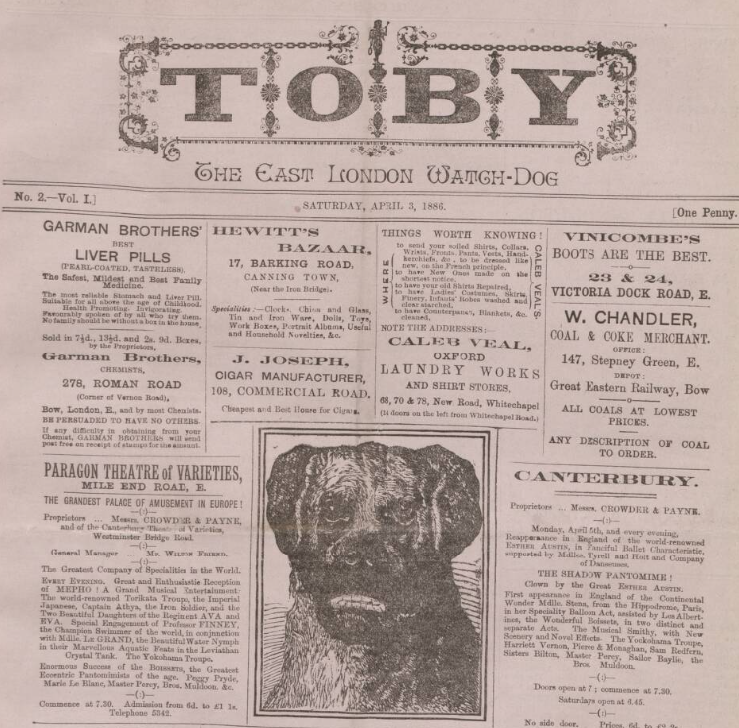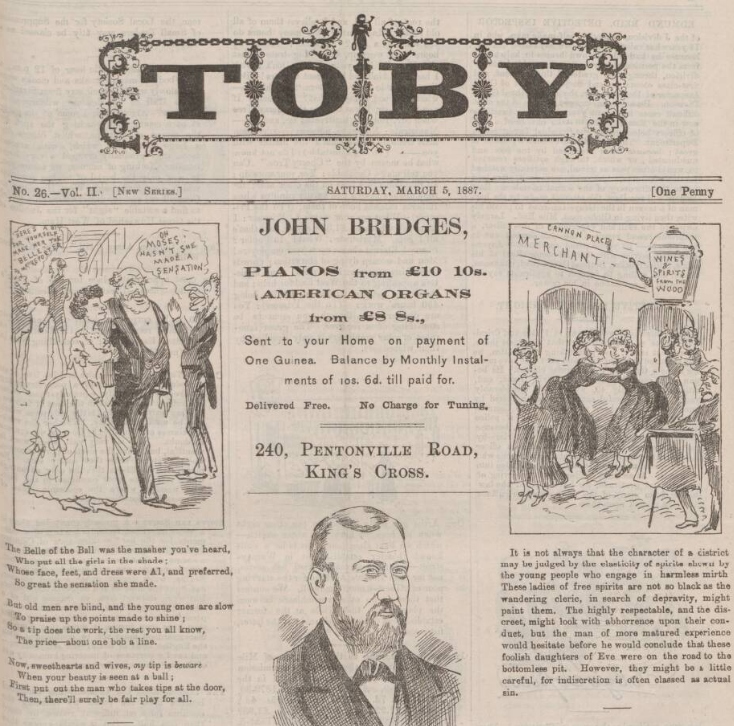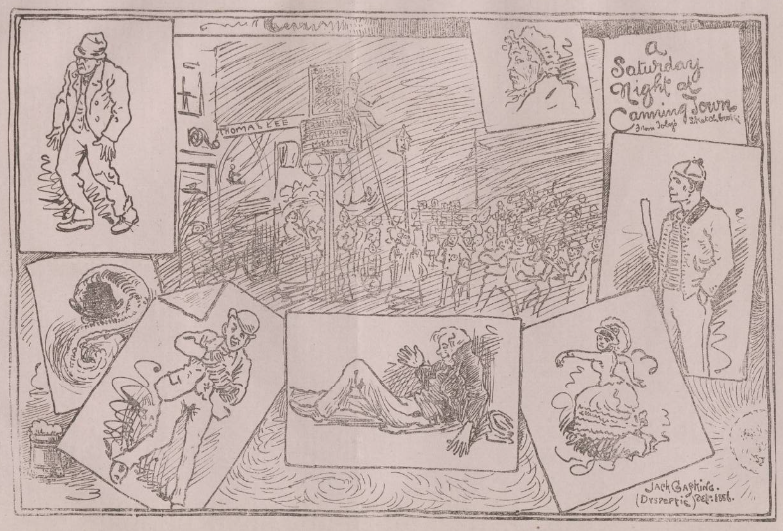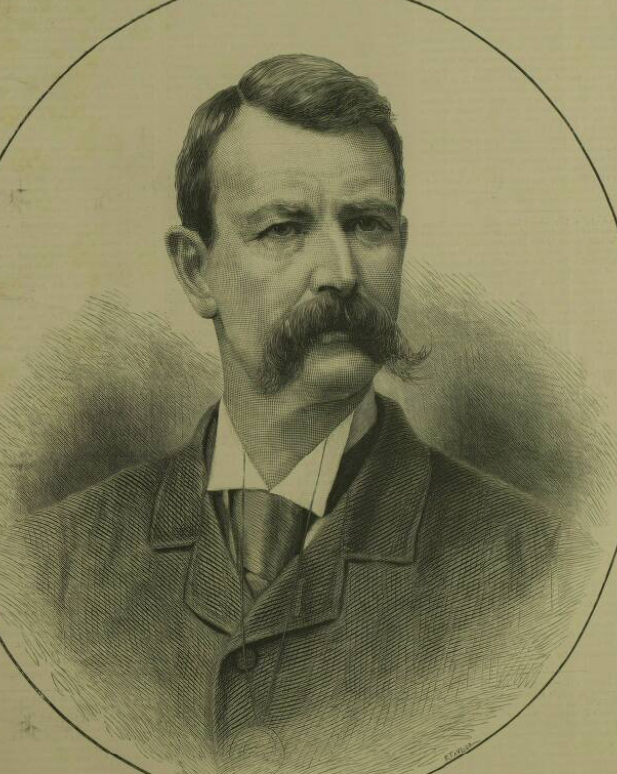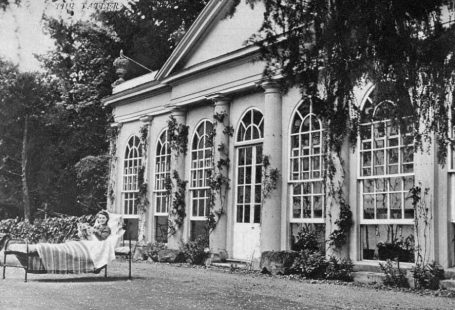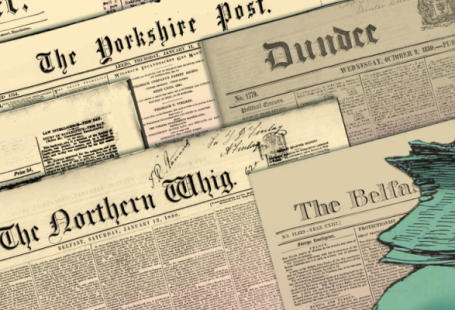This week at The Archive we are delighted to welcome one splendid brand new title to our collection – Toby – the ‘East London Watch-Dog‘ – which provides us with a fascinating insight into attitudes to the police in Whitechapel at the time of Jack the Ripper. That’s not all, over the last seven days we’ve added 89,020 brand new newspaper pages, whilst we’ve made important updates to our newspaper titles from across England, Scotland and Northern Ireland.
So read on to discover more about all of our new and updated titles of the week, and also to learn more about Toby’s frustration with the London police in the wake of the infamous crimes of Jack the Ripper.
Register now and explore the Archive
When perusing the British Library catalogue our digitisation team found a publication named Toby. We thought that it was only right to digitise this title, given that one of the core members of the British Newspaper Archive team is named Toby Atkin-Wright. It’s fair to say that without Data Ingest Manager Toby there would be no Archive, since he has worked on the project since day one, keeping the data flowing and ensuring that all of our newspaper pages are available for you to search. So as our way of saying thank you to Toby for all his years of hard work, we present Toby to the world for the first time, at least in digital form, this week.
So as Toby makes his bow to the world, we delved into the pages of what turned out to be a simply fascinating publication. Toby, or the ‘East London Watch-Dog,’ bounded onto the newspaper scene on 27 March 1886 at the price of just one penny. Printed from the Railway Cigar Stores, on the appropriately named Barking Road in London’s East End, nestled between Plaistow and East Ham, Toby was set to appear every Saturday, regularly filling twelve pages.
As Toby made his debut, he explained to his readers, whom he addressed as his ‘Fellow East Enders and Suffers,’ that his publication was to be ‘an illustrated satirical paper for the struggling, poor, deserving, yet much abused East of London.’ He was to be a ‘watch-dog’ then against the ‘evils’ of society, the abuse and exploitation of the poor, using humour as his weapon.
So what then would the pages of Toby include? Across its two columns, it would take in such topics ‘as local celebrities,’ music, drama, education and local society meetings, all reported on in Toby’s own particular style:
Under the head of LOCAL CELEBRITIES, men who have deserved well of their fellows will be faithfully, but not flatteringly described. TOBY will be fair and just in all his reports of meetings; and his Wit, Anecdote and Mirth, will always please and instruct, but never at the expense of truth and good morals. His Music and the Drama will always be elevating, never degrading. His Science, Art, and Education, whether in public, private, or endowed schools; whether by day or night…will praise the best modes and denounce the worst ones; will commend those which are useful and satirize those that are useless.
Toby was, therefore, set to be quite the crusader, not only taking on public figures and institutions, but also attacking the working classes where he saw fit. For example, on 27 March 1886 Toby described how:
Canning Town, on Saturday night, has become a disgrace to civilisation. From the Iron Bridge to the so-called Canning Town Railway Station, Pandemonium reigns. Men and women, boys and girls, drunk or half drunk, singing, or shouting filthy songs, take possession of the pavement, and become a perfect terror to quiet passers-by.
Such an assessment was followed a week later by a ‘cartoon‘ of these scenes.
Alongside such stinging characterisations of contemporary life, Toby was full of descriptions of local goings-on, from looks at the music halls and the concerts taking place in the area, to opinion pieces on organisations like the West Ham Board of Guardians and the Education Reform League. The paper also contained items of gossip, which were mainly included in the ‘Can’t Think Why‘ section, with observations like:
Mr W. Dunton, tailor, Mile End-road, had the conscience to get married to Miss Goddard, daughter of Mr. Goddard, ‘Royal Hotel,’ Mile End-road, on the 18th inst., without acquainting Toby of the fact.
We do hope you enjoy browsing the pages of Toby as much as we have done. Meanwhile, we have updated eight of our newspaper titles this week, with a trio of Scottish newspaper titles being updated. We have added important early years to the Aberdeen Press and Journal, which is celebrating its remarkable 275th anniversary this year. Not only is this historic newspaper Scotland’s oldest daily newspaper, it is one of the world’s longest-running newspapers. Alongside the Press and Journal, our other updated Scottish titles are the Dundee Evening Telegraph and the Lennox Herald.
Meanwhile, this week also sees significant updates to the Sutton & Epsom Advertiser, with over 14,000 brand new pages covering the years 1929 to 1960 joining this title, whilst across the Irish Sea we have added new pages from the 1960s to the Londonderry Sentinel.
Exploring Attitudes to the Police at the Time of Jack the Ripper
As our new publication Toby covers those years that infamous killer Jack the Ripper was active in London’s East End, we thought we’d dive into the newspaper’s pages to find a fresh perspective on the one of the world’s most notorious criminals, and the devastation he left behind. And we weren’t disappointed, finding within the pages of Toby stinging criticisms of the London police force and their inability to catch the unidentified killer, although, none of his victims are named in the publication.
On 13 October 1888, between the murders of Elizabeth Stride and Catherine Eddowes on 30 September 1888 and that of Mary Jane Kelly on 9 November 1888, Toby published the following piece, which was ‘Dedicated to the Whitechapel Detectives:’
The dreadful murders and mutilations which have been committed in Whitechapel during the last few weeks have stricken terror into hundreds of thousands who live in the East End and adjoining districts of London. In fact, this epidemic of murder has spread with great rapidity; but, although hundreds of detectives are at work, they seem as far off as ever from laying hands on the perpetrator. The detective system has, in short, broken down.
However, Toby saves its harshest criticism for Police Commissioner Sir Charles Warren, labelling him ‘that official imbecile.’ In Toby’s mind, at least, the London Police as a force was not fit for purpose.
As 1888 came and went, rumours of Jack the Ripper continued to permeate the pages of Toby, despite no crimes being attributed to him taking place in 1889. On 27 July 1889 Toby reported how Jack the Ripper had been seen in the public gardens at Braintree, whilst on the same day the paper detailed a rumour from Ongar:
Here’s some lunatic who has invented a theory that Jack the Ripper is, or has been, a carrier. He commits a murder, walks cooly up to the Whitechapel waggons and then all trace of him is lost, because he may be dressed up as a waggoner.
On 31 August 1889, under its ‘Agony Column,’ a writer took to goading the killer:
Jack Ripper. Why this long silence? We shall be glad to see you once more. They are anxiously waiting. Send address to Commercial street station, or to Mr. A. Bachart, there’s a good fellow.
Of course, the lines are in incredibly bad taste, but bely the desperation of the police in trying to solve the case. And in September 1889, it appeared that the letter writer’s wishes were fulfilled, when a torso of an unidentified woman was found underneath an arch on Pinchin Street, Whitechapel. Although the so-called ‘Pinchin Street torso’ is not generally thought to be a victim of the Ripper, at the time she was thought to be, as Toby reveals:
Once more we have been shocked by the news of another of those diabolical murders of Whitechapel which have made the name – if name it can be called – of Jack the Ripper, one that will be for ever associated with everything that is fiendish and horrible.

In the wake of this horrific murder, Toby again aired its frustrations with the police:
Who he is, what he is, or where he is, is up to the present a profound mystery; one, too, that has baffled even the wits of some of perhaps the greatest detectives of modern times. The whole London Police Force have been simply set at naught, whilst crowds of detectives, professional and amateur, which have swarmed in and around Whitechapel and in fact all over the East End have been hopelessly played with, until the angered public are doubting their abilities and sneering at their seeming weakness.
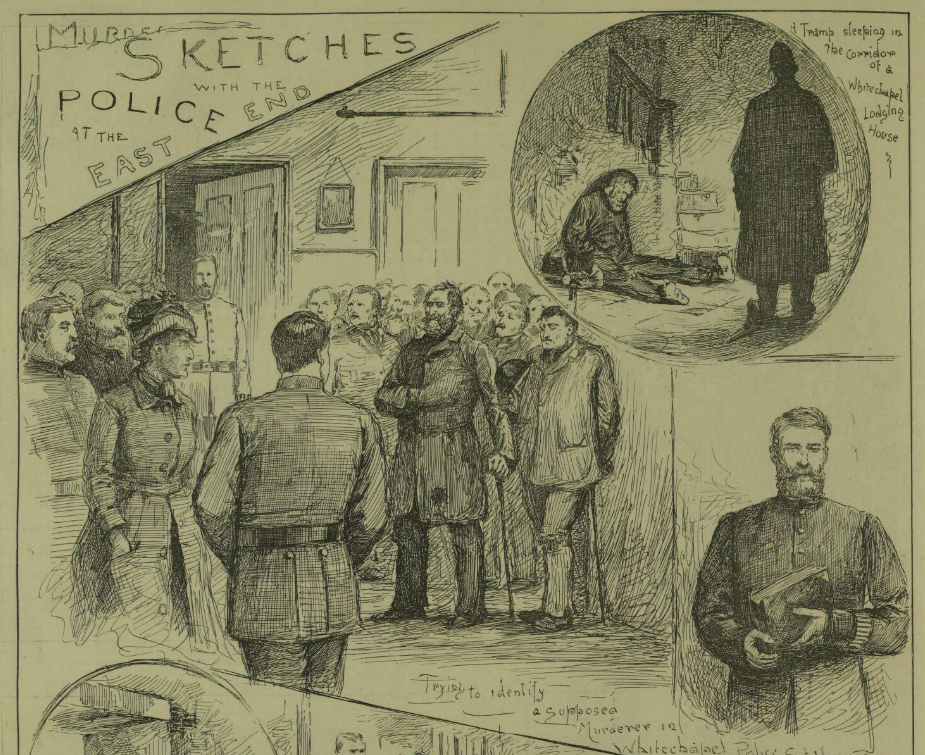
When looked at seriously it is truly marvellous that such murders should be allowed to go undiscovered in the face of all this and in perhaps one of the most thickly populated districts in the world. Look at it in what light we may it is a profound mystery, and one which is perhaps unparalleled in the annals of crime.
However, Toby had some kind words for Detective Inspector Frederick Abberline, a name which is perhaps the most closely associated with the investigation. On 21 September 1889 Toby included a sketch of the police inspector, lauding both ‘his official and private virtues.’ The piece goes on to explain how:
He has a decent amount of curiosity, and has been known to stop gentlemen at the most unholy times and places and enquire most affectionately about their heath and work – questions which are often settled by a magistrate, generally in Mr. Abberline’s favour. It is this habit of curiosity that makes him so eager as to the whereabouts of Jack the Ripper. We hope and trust his eagerness in this direction may be successfully gratified. In either way it will not be for the want of determination and hard work on his part.
Of course, Abberline would be unsuccessful in his quest to unmask the identity of Jack the Ripper, and bring to justice the man who took the lives of Mary Ann Nichols, Annie Chapman, Elizabeth Stride, Catherine Eddowes and Mary Jane Kelly, and perhaps other women too.
Find out more about the victims of crime, life in the East End, and much more besides, in the pages of our newspapers today.
New Titles
| Title | Years Added |
| Toby | 1886-1889 |
Updated Titles
This week we have updated eight of our existing titles.
You can learn more about each of the titles we add to every week by clicking on their names. On each paper’s title page, you can read a FREE sample issue, learn more about our current holdings, and our plans for digitisation.
| Title | Years Added |
| Aberdeen Press and Journal | 1753-1757, 1768-1772, 1783-1797, 1885 |
| Atherstone News and Herald | 1993-1995, 1999 |
| Crowthorne Times | 1984-1986 |
| Dundee Evening Telegraph | 1986, 1988, 1991 |
| Gloucestershire Echo | 1993 |
| Lennox Herald | 1998 |
| Londonderry Sentinel | 1960, 1963-1965 |
| Sutton & Epsom Advertiser | 1929-1931, 1933-1942, 1945-1953, 1955-1958, 1960 |
You can keep up to date with all the latest additions by visiting the recently added page. You can even look ahead to see what we’re going to add tomorrow.


